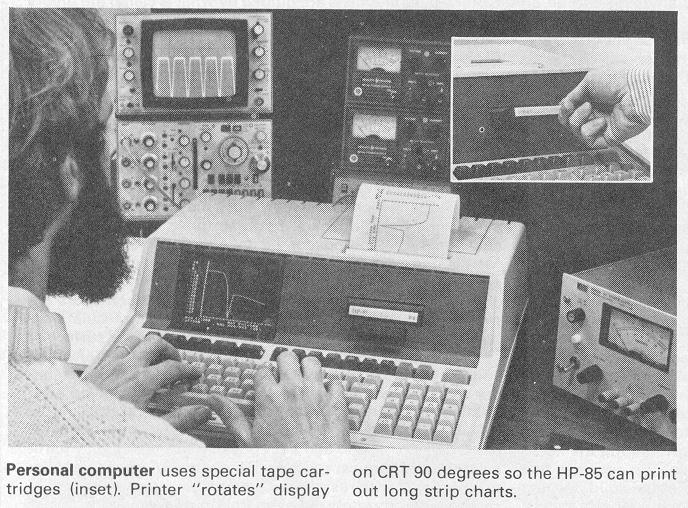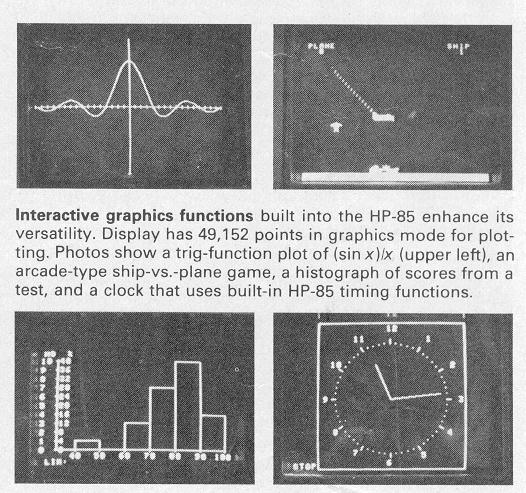
Typewriter-sized computer
has video display, tape drive, and printer

This portable package solves complex problems at your home or office
By JOHN FREE
A compact all-in-one computer designed for home, business, or industry has been introduced by Hewlett-Packard Co. The 20-pound HP-85 computer includes a five-in. video-display tube (CRT), a printer with 4.3-in.-wide thermal paper, tape-cartridge drive, full-size keyboard, and an excellent BASIC language in its memory.
 I tried an HP-85, comparing it with two other personal computers
I've been operating for years that require separate plug-in
peripherals. My conclusion: While the $3250 HP-85 costs more
than what you might pay for separate components (TV, printer,
tape machine) and a bare-bones personal computer, the operating
convenience of the 85 and compatibility its optional accessories
can make it worthwhile. There's none of the usual hassle
interfacing components from separate manufacturers. The HP-85 is
clearly a professional model from a firm long in the business of
making expensive desk-top scientific units.
I tried an HP-85, comparing it with two other personal computers
I've been operating for years that require separate plug-in
peripherals. My conclusion: While the $3250 HP-85 costs more
than what you might pay for separate components (TV, printer,
tape machine) and a bare-bones personal computer, the operating
convenience of the 85 and compatibility its optional accessories
can make it worthwhile. There's none of the usual hassle
interfacing components from separate manufacturers. The HP-85 is
clearly a professional model from a firm long in the business of
making expensive desk-top scientific units.
One example of the built-in operating convenience is the HP-85 graphics capability. Part of the computer's read/write memory can be "mapped" on the CRT. A pattern of tiny dots (256 wide by 192 high) can be actuated to form displays for scientific, business, or entertainment functions. Also, anything on the CRT graphics display can easily be captured on the heat-sensitive printing paper.
I've tried a number of graphics boards and graphics programs for personal computers, but even combined they don't match the versatility of the 85's graphics. Especially useful, for example, are commands built into its BASIC that scale and label increments on the vertical and horizontal axes and automatically put tick marks along these lines.
But one exception to the operating convenience in graphics is the tedious programming needed to create special graphic symbols. While HP isn't marketing the 85 for those who want to create card displays or fast-drawing gun sligners for computer games, the work needed to program these symbols is far too complex. No doubt a clever programmer will devise a technique to simplify this.
 The small CRT size makes graphics displays appear sharper than
on a larger screen with 256-by-192 resolution. This minimizes
the jaggedness of diagonal lines (see clock minute hand in photo).
But the small screen size, while good for graphics, is taxing
on the eyes in the alphanumeric mode. Readability suffers with a
full screen (16 lines by 32 characters).
The small CRT size makes graphics displays appear sharper than
on a larger screen with 256-by-192 resolution. This minimizes
the jaggedness of diagonal lines (see clock minute hand in photo).
But the small screen size, while good for graphics, is taxing
on the eyes in the alphanumeric mode. Readability suffers with a
full screen (16 lines by 32 characters).
Fast Tape
Instead of the irritatingly slow 1 7/8 ips of conventional cassettes,
the HP data cartridges have a read/write speed of 10 ips, and a
search speed of 60 ips. Programs can be quickly stored or accessed
by name through BASIC commands. A cartridge lasts 50 to 100 hours,
so a disc setup is preferable for frequent access to programs or
data files. Each cartridge stores 195K bytes of programs or 210K
bytes of data.
The HP-85's BASIC is unusually complete, features 12-digit accuracy, and has an exponent range of +/- 499 for very large or small computed numbers shown in scientific notation. (BASIC's I've been using stop and give you "over-range" warnings if the computed answer is more than 33 places.) Arc functions for trig, such as arccosine, and functions such as cosecant are standard in the 85, but rare in other BASIC's. The BEEP BASIC command operates a built-in speaker, enabling you to program music. Also, a DATE and related clock commands bring timing functions to your programs. THere are 42 predefined BASIC functions.
HP's software programs cost $95 each, and the few I tried seem like a bargain. Included in an expanding library are programs for finance, math, circuit analysis, regression analysis, linear programming, waveform analysis, and more. Additional information on the HP-85 is available from: Inquiries Manager, Hewlett-Packard Co., 1507 Page Mill Rd., Palo Alto, Calif. 94304.
PS
Click here for the home page.
Click here for the wanted page.
Updated February 28, 2003